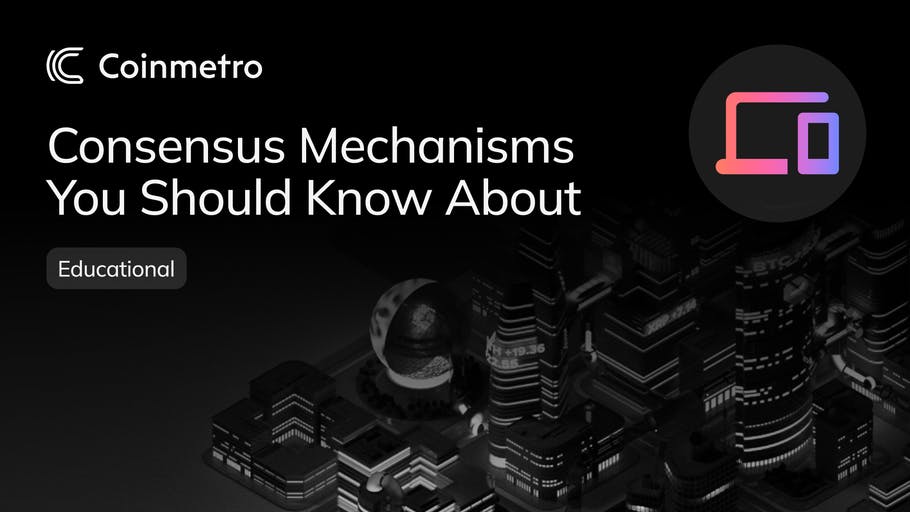Blockchain Consensus Mechanisms – A Beginner’s Guide
December 5, 2025

by Kamil S
December 5, 2025
Every blockchain operates using a consensus mechanism, which differs from network to network depending on the required resources and the desired outcome. In this guide, you will find the most widely used blockchain consensus mechanisms you should definitely know about.
A consensus mechanism, also known as a consensus protocol or a consensus model, is an algorithmic procedure, through which all the users of a blockchain network reach a common agreement about the present state of a decentralized ledger.
Essentially, this core part of all blockchain networks makes sure that every single new block added to the blockchain is the one and only version of the truth agreed upon by all the nodes in the chain.
What are the various blockchain consensus mechanisms and how do they work?
First proposed in 1993 and popularized in 2008 by its use to validate new blocks in the Bitcoin blockchain, PoW is a form of cryptographic proof in which one party proves to other parties that a certain amount of a specific computational effort has been expended. Verifiers can confirm this expenditure with minimal effort on their part.
PoW is widely used in mining crypto to validate transactions and mine new tokens.
First introduced in 2012, the PoS consensus mechanism operates by selecting validators in proportion to their quantity of holdings in the associated cryptocurrency. This method is employed to circumvent the computational cost of PoW schemes – PoW is utilized to secure networks by imposing a computational cost on participating devices. Therefore, the foundation of PoS does not necessitate additional energy to establish trustworthiness because it relies on stake, not power, to achieve consensus across the network and mint new blocks. As a result, it is much more energy efficient and sustainable than PoW. This is one of the reasons why Quant's PoS protocol is considered more environmentally friendly and sustainable compared to traditional PoW-based blockchains.
Based on PoS and introduced by Solana, PoH attempts to reduce the load on network nodes while processing blocks by incorporating the concept of time into blockchain technology.
Gaining consensus on the time a block was mined is crucial because timestamping informs the network and its every participant that transactions occurred in a specific order.
An advancement of PoS, DPoS allows users to stake their coins to vote for the elected “delegates”, who will validate the next block in the chain. Put differently, users will add their coins to a staking pool, linking them to a selected “delegate”. This blockchain consensus mechanism enables users to choose the people they want to see as validators (i.e., elected “delegates”).
Another version of PoS is LPoS, used primarily on the Waves platform. As can be guessed from its name, this consensus model allows token holders to “lease” their tokens to full nodes and get rewarded as a result.
What makes LPoS different from a regular PoS environment is that users can choose between running a full node or leasing their stake to a full node to earn rewards.
Developed by NEM (New Economy Movement), PoI is a new blockchain consensus mechanism used to establish which network participants – nodes – are eligible to add a new block to the blockchain, a process known as “harvesting”.
Also known as Proof-of-Space, PoC is an energy-efficient consensus mechanism – similar to PoS and PoI – allowing nodes to use the empty space available on their hard drives to mine crypto.
Developed by Intel Corporation, the innovative PoET consensus mechanism enables permissioned blockchain networks to determine who creates the next block.
If “permissioned blockchain” sounds Greek to you, then this type of network requires permission or invitation to join the network as a participant or node.
PoA is a consensus model marrying the best features of PoW and PoS.
This hybrid mechanism is used to ensure that all transactions on the blockchain are genuine. Moreover, it makes sure that all miners arrive at a consensus.
PoA is an algorithm that delivers faster transactions through a consensus mechanism based on identity as a stake, whereas transactions and blocks are validated by approved accounts, known as validators.
An upgraded, improved form of PoA, PoR is a blockchain consensus mechanism that depends on the reputation of the participants to keep the network secure.
Simply put, PoR ensures the network blocks are validated by authorized accounts or validators. In PoR blockchains, authorized accounts must be trusted and reputable. If they ever were to attempt to cheat the system, they would face significant consequences.
Read more about the concept of Proof-of-Reputation
As the name suggests, PoB involves burning coins, which grants the miner the right to sign a new block. Burning just one coin gets miners a permanent right to sign new blocks. However, the probability of being selected for the next block increases with the number of burned coins.
ZKP is a mechanism requiring one party (the prover) to prove the truth of specific information to another party (the verifier) without disclosing any additional information.
Used by the Helium blockchain, the novel PoC algorithm allows the network to reward users for verifying coverage.
Helium is an open-source blockchain network launched in 2019, designed to power Internet-of-Things (IoT) devices with wireless connectivity.
Participants deploy Hotspots to help build and expand the network. These Hotspots are given random and automatic tests to cryptographically prove that they are indeed providing radio coverage in a particular place and a particular time. Passing a test earns a Hotspot operator Helium rewards.
Every known blockchain operates using a consensus mechanism. To date, Proof-of-Work is considered the most reliable of all the consensus mechanisms discussed in this article, even though it has some drawbacks and its scalability issues are rife.
As blockchain consensus mechanisms address the issue of how consensus is achieved in a particular network, with the launch of new blockchains, we will be witnessing the emergence of other innovative algorithms.
You can now join Coinmetro’s Discord and Telegram communities to stay up to date with the latest crypto developments or to be better informed about how things work in the ever-evolving cryptoverse.
But don’t stop there, sign up to our platform in just a few easy steps to start trading crypto today!
Tags
Related Articles

Regulatory Sandboxes: Fostering Crypto Innovation Within Legal Frameworks
The cryptocurrency industry’s fast rise fuels an important debate. Innovation aims to transform finance, enhancing speed and access. Yet, regulators…
5m

Crypto Options Trading: Strategies and Market Insights
Cryptocurrency markets have rapidly expanded beyond simple buying and selling. One of the most significant developments has been the rise of…
6m

The Rise of Social-Fi: Blending Social Media with Decentralized Finance
In recent years, social media and finance have started to merge, creating Social-Fi. This concept blends the engagement of social platforms with…
6m

DeFi Insurance Platforms to Watch in 2024
Decentralized Finance (DeFi) insurance addresses the growing need for insurance against hacks, smart contract failures, and other DeFi-related risks.…
7m